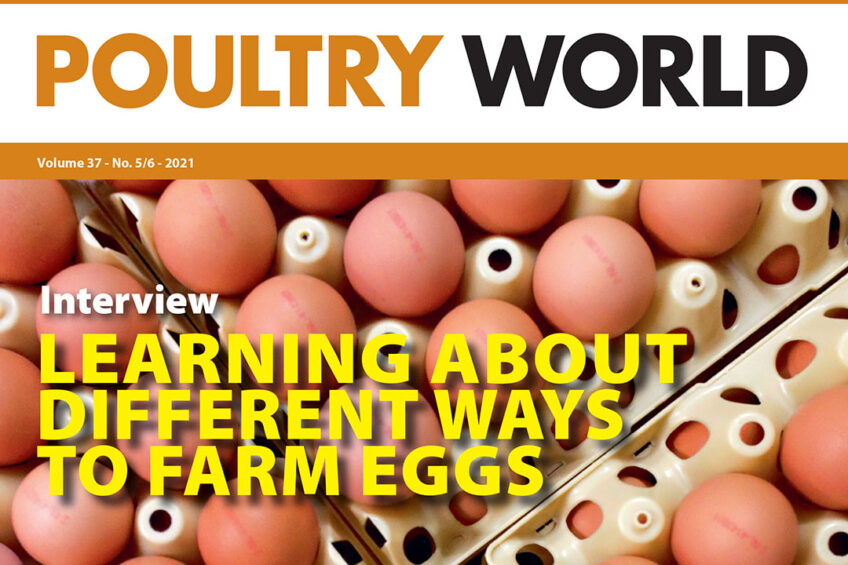Poultry World edition 5 of 2021 now online

In this 5th edition of Poultry World, Canadian Jon Krahn shares his experience one year into the Young Egg Leader programme, an initiative designed to teach future industry leaders about the different ways to farm eggs. Then, a visit to CP Foods’ first-ever Thai cage-free certified Wang Somboon farm, and a look into a toolkit of protocols to help overcome some of the challenges in maintaining effective biosecurity practises.
View number 5 issue of Poultry World
Learning about different ways to farm eggs
Every year the International Egg Commission welcomes 6-8 new participants into its Young Egg Leader programme. During this leader development initiative, participants benefit from industry presentations, leadership seminars and roundtable discussions. Canadian Jon Krahn was selected and one year into the programme he shares his experience with Poultry World.
Russian turkey and duck meat renaissance
Russia’s domestic demand for unconventional poultry meat proved to be strong in 2020, despite the Covid-19 pandemic. Local analysts predict that turkey, duck and quail meat will drive future growth in the industry, a sentiment shared by investors.

Consistently improving poultry farming processes
Innovative solutions are required from across the poultry industry to assist producers in improving their farming processes. Cutting carbon emissions in the egg sector, the pros and cons of slower growing birds, and the latest on-farm hatchery developments, were in focus at this year’s poultry meat and egg sessions at the Pig and Poultry Forum.

Histomoniasis a headache for poultry producers
North America and Europe are among some of the regions that have seen the re-emergence of Histomoniasis, or blackhead. With the ban on many of the medications used to fight the disease, the focus has shifted to prevention. Poultry World explores.

View number 5 issue of Poultry World
CP Foods revs up cage-free production
Charoen Pokphand Foods (CPF) has a cage-free production strategy in place which is designed to meet the increasing demand from the food service industry and consumers concerned about animal welfare. Senior VP, Somkid Wannalukkhee, shares his thoughts on its first-ever Thai cage-free certification for its showcase Wang Somboon farm.

Ways the US layer industry deals without antibiotics
With 43% of surveyed consumers revealing that they “always” or “often” buy poultry raised without antibiotics, a tipping point may have been reached. Poultry World looks into the most important factors producers must incorporate into modern poultry rearing and management.

France considering vaccination against AI
In response to the consistent outbreaks of highly pathogenic bird flu (HPAI), which have cost the local poultry industry hundreds of millions in damages and lost revenue, the French ministry of agriculture is now contemplating the rollout of preventive vaccinations as from 2022.

Benefits of seaweed-based pellet binders in broiler diets
Following a recent study, researchers have concluded that the use of binding agents from natural sources such as seaweed not only help achieve the desired pellet quality but also improve the growth performance and feed efficiency in broilers.

View number 5 issue of Poultry World
Biosecurity breaches major contributing factor in disease outbreaks
Biosecurity measures are designed to protect livestock from infection but must be applied consistently to be successful. Poultry World considers a toolkit of protocols to help overcome some of the challenges in maintaining effective biosecurity practises.

Implications of peptidoglycans for gastrointestinal functionality
The risk of excessive bacterial cell wall fragments, mainly peptidoglycans (PGNs), to intestinal health and optimum production is constant. Poultry World explores a new study which confirms the positive effects of supplementing diets for broilers with an exogenous muramidase.

Boosting turkey reproductive output
The daylength timing mechanism that regulates reproduction provides only a seasonal window when animals, like turkeys, are able to reproduce. Researchers are now seeking to develop strategies to overcome the constraints that the seasonal cycle imposes.

To access the magazine section, where you will find the 5th edition of Poultry World 2021 as well as other magazines from specialists in the agriculture industry, simply register for free.












